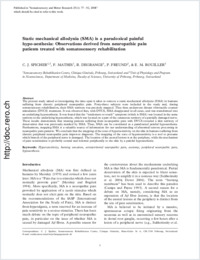Static mechanical allodynia (SMA) is a paradoxical painful hypo-aesthesia: Observations derived from neuropathic pain patients treated with somatosensory rehabilitation
- Spicher, Claude J. Somatosensory Rehabilitation Centre, Clinique Générale, Fribourg, Switzerland - Unit of Physiology and Program in Neurosciences, Department of Medicine, Faculty of Sciences, University of Fribourg, Switzerland
- Mathis, F. Somatosensory Rehabilitation Centre, Clinique Générale, Fribourg, Switzerland
- Degrange, B. Somatosensory Rehabilitation Centre, Clinique Générale, Fribourg, Switzerland
- Freund, Patrick Unit of Physiology and Program in Neurosciences, Department of Medicine, Faculty of Sciences, University of Fribourg, Switzerland
- Rouiller, Eric M. Unit of Physiology and Program in Neurosciences, Department of Medicine, Faculty of Sciences, University of Fribourg, Switzerland
-
2008
Published in:
- Somatosensory and Motor Research. - 2008, vol. 25, no. 1, p. 77 - 92
Hypersensitivity
burning sensation
extraterritorial neuropathic pain
axotomy
peripheral neuropathic pain
hypoaesthesia
English
The present study aimed at investigating the time span it takes to remove a static mechanical allodynia (SMA) in humans suffering from chronic peripheral neuropathic pain. Forty-three subjects were included in the study and, during somatosensory rehabilitation, their SMA territory was precisely mapped. They then underwent distant vibrotactile counter stimulation (DVCS) treatment. It was observed that, with DVCS, SMA disappeared in all cases, and was transformed into an underlying hypoaesthesia. It was found that the “tenderness to touch” symptom (which is SMA) was located in the same territory as the underlying hypoaesthesia, which was located on a part of the cutaneous territory of a partially damaged nerve. These results demonstrate that treating patients suffering from neuropathic pain with DVCS revealed a skin territory of denervation that was previously masked by SMA. Thus, SMA can be considered as a paradoxical painful hypoaesthesia. Furthermore, mapping SMA is a valuable source of information for our understanding of abnormal sensory processing in neuropathic pain patients. We conclude that the mapping of the zone of hypersensitivity on the skin in humans suffering from chronic peripheral neuropathic pain improves diagnosis. The mapping of the zone of hypersensitivity is a tool to presume which branch of the peripheral nerve is damaged. The location of the axonal lesions is at the periphery, while the mechanism of pain sensitization is probably central and referred peripherally to the skin by a painful hypoaesthesia.
- Faculty
- Faculté des sciences et de médecine
- Department
- Département de Médecine
- Language
-
- English
- Classification
- Biological sciences
- License
-
License undefined
- Identifiers
-
- RERO DOC 9235
- DOI 10.1080/08990220801942748
- Persistent URL
- https://folia.unifr.ch/unifr/documents/300621
Statistics
Document views: 165
File downloads:
- pdf: 564
